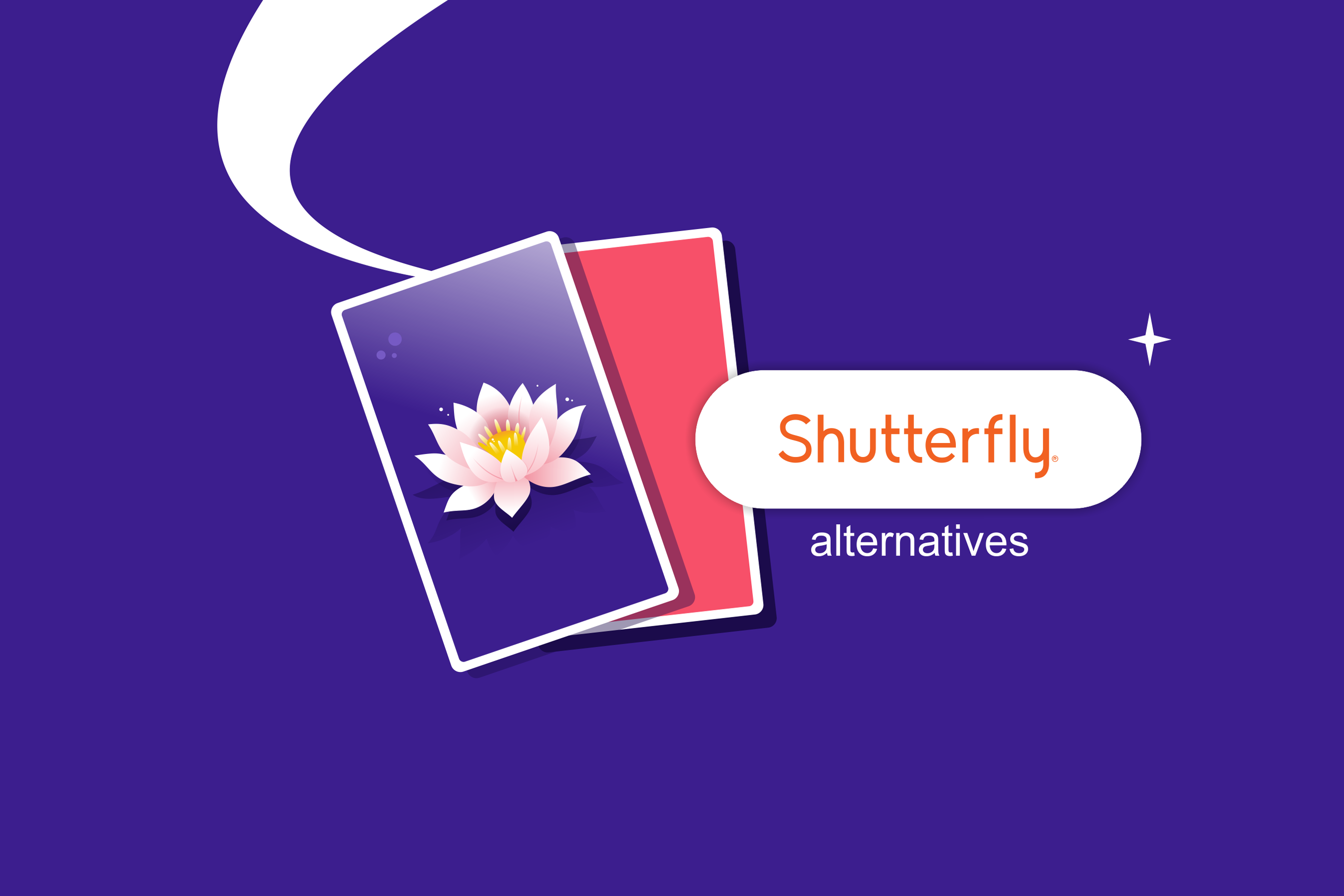The global greeting card market was worth about $21.8 billion in 2024, according to recent research.
That means the coming years will bring plenty of room for fresh voices, niche cards, and small brands to thrive.
If you're creative at heart and want to start earning, print-on-demand business makes starting low-risk. You design from home and skip stocking inventory. There are no big upfront costs, no warehousing, and no unsold stock headaches to face.
This post is a friendly roadmap on how to start a card business and make your first sale.
Let’s walk from idea to your first paid order, step by step together.
Is a Greeting Card Business Profitable?
Interestingly, according to Grand View Research, the global greeting cards market size will reach USD 20.66 billion by 2030, growing at a CAGR of 0.9%.
With low startup costs and consistent demand, greeting cards can turn a good profit. What really sells are personal, niche designs that feel authentic and made with love.
To start a greeting card business, POD can be your first risk-free step. You can avoid bulk orders and storage, so profit margins improve from day one.
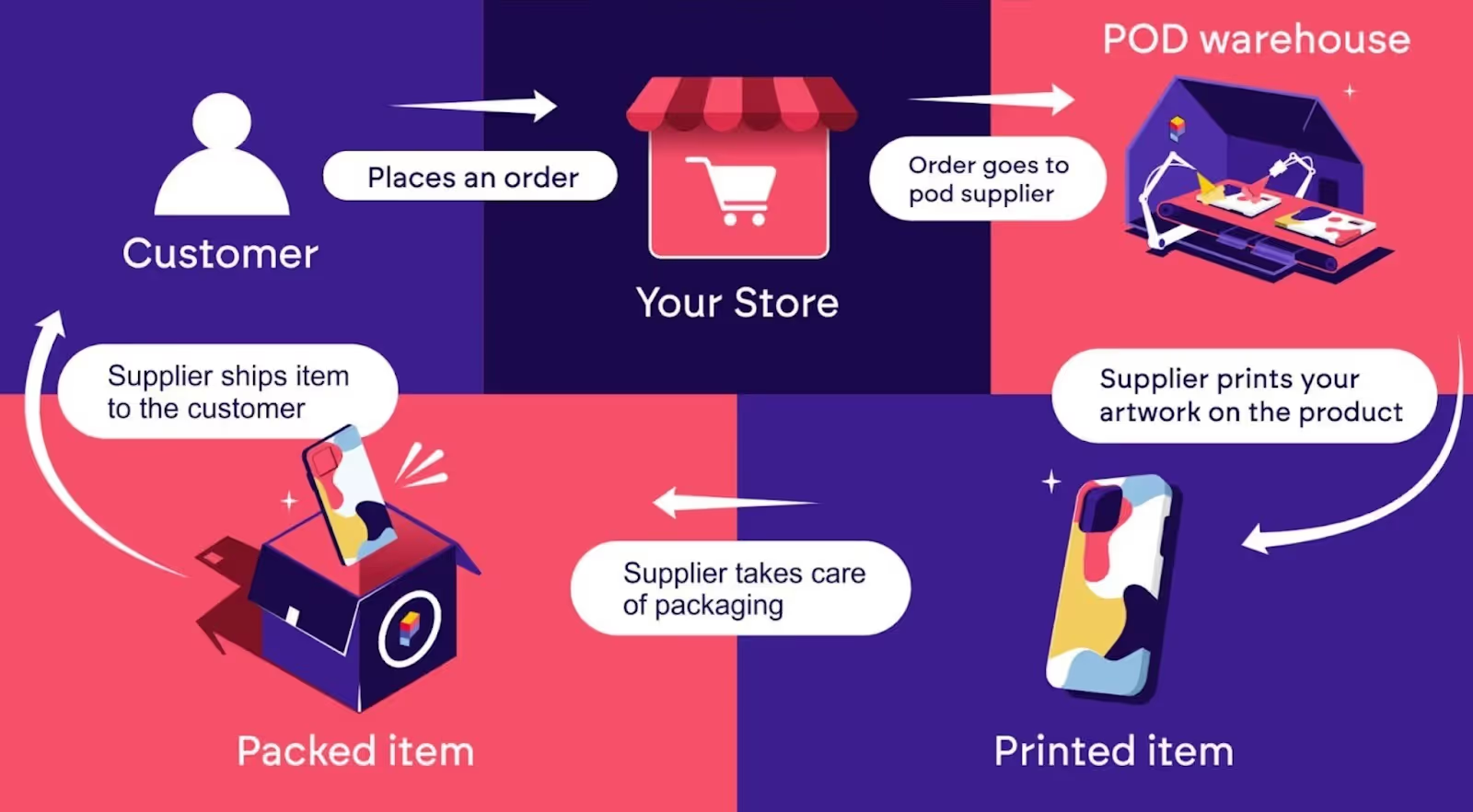
You can also consider other best-selling POD products in addition to custom greeting cards to widen your audience base.
Also Read:
- How to Make Your First Sale Online: A Step-by-Step Guide
- How to Sell on Amazon Without Inventory (Step-by-Step)
How to Start a Card Business: A Step-By-Step Guide
Want to learn how to start a card business? Here’s a simple guide.
Step 1: Find Your Niche Market
Generic cards fade into the background among thousands of similar designs online. Niche cards feel personal and relatable, which makes buyers more likely to choose them.
Here’s how to choose one:
- Pick topics you already care about; your passion shows here.
- Look through Etsy, Amazon, and Pinterest for bestsellers and catchy designs.
- Note styles or messages missing from stores, especially those customers ask for often.
- Run quick Pinterest and Google queries to confirm steady interest before investing.
If you’re figuring out how to start a card business, here are some popular niches to choose from:
- Funny cards with dark humor
- Minimalist designs for modern aesthetics
- Pet-themed cards for animal lovers
- Milestone cards
- Eco-conscious cards with sustainability messaging
- Custom photo cards for personalization
- Pop culture reference cards
- Wellness and mental health encouragement cards
Step 2: Conduct Market Research
Doing market research is a non-negotiable step when learning how to start a card business. Begin researching by building a clear profile of your ideal customer and buyer habits. Study their:
- Demographics: Age groups, metro vs rural, family size, and career type.
- Buying Patterns: Preferred platforms, average spend, gift vs casual purchase frequency.
- Interests: Preferred humor, cultural touchstones, causes they support, and popular hobbies.
Next, you should study the competition by:
- Comparing the bestsellers’ visuals, price ranges, shipping times, and product descriptions.
- Reading reviews carefully to spot repeated complaints or wishlist features.
- Tracking rivals’ Instagram and TikTok for posting cadence, influencers, and promotions.
Tools for Market Research
- Google Trends: Compare interests across regions and see seasonal demand peaks
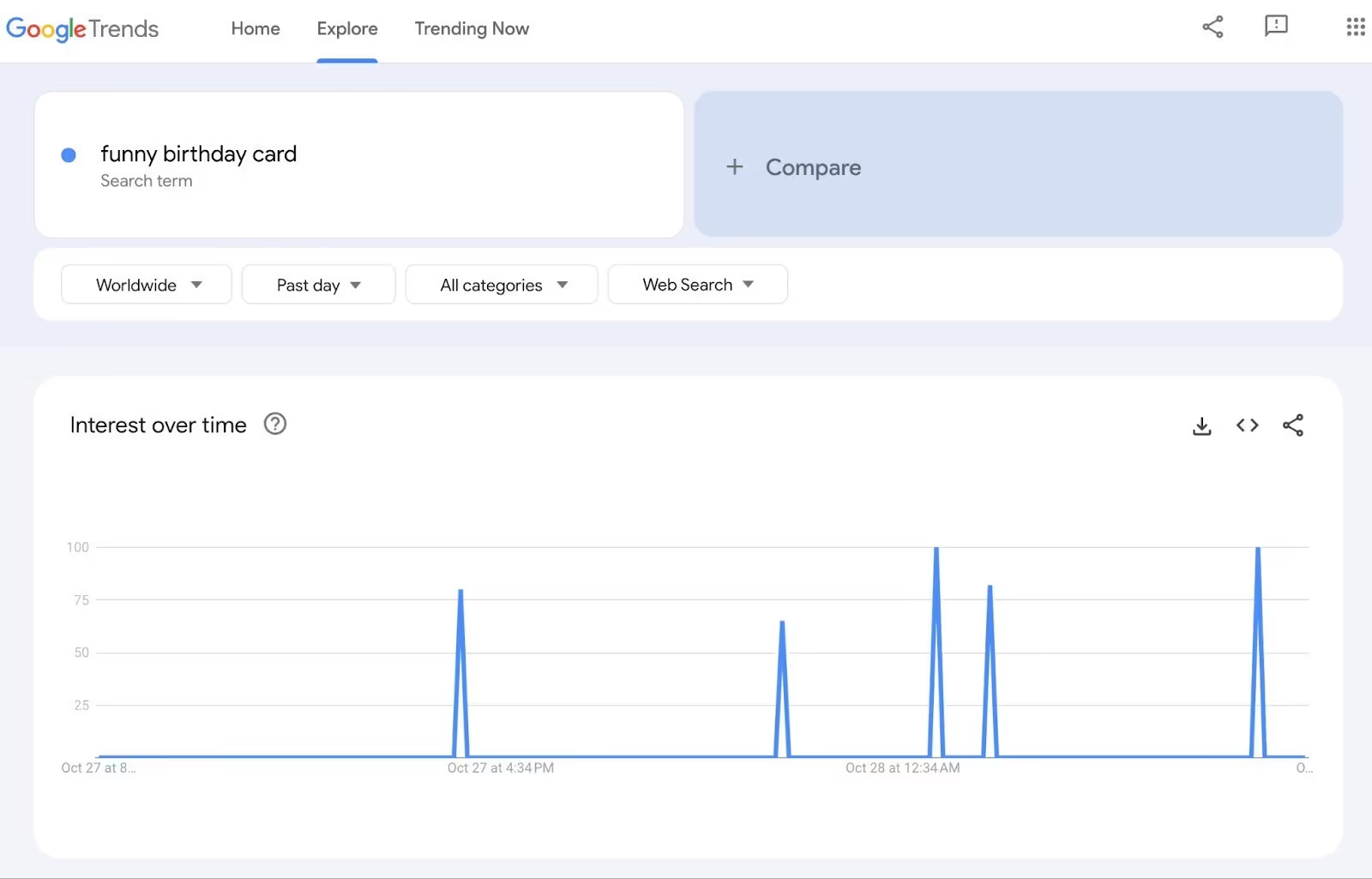
- Pinterest Trends: Find aesthetic directions and frequently saved card styles.
- Etsy/Amazon: Watch autocomplete and related searches to learn buyer language.
- Hashtags: Follow #greetingcards, niche tags, and comment threads for real signals.
Step 3: Plan Your Greeting Card Business
Proper planning gives you a compass when starting a greeting card business from home and limits wasted effort. A quick plan keeps product, pricing, and marketing decisions consistent and measurable.
Here’s how you can create a business plan.
- Pick a business name and decide the tone.
- Outline the niche, buyer persona, and key occasions your cards will target.
- Decide core SKUs, special editions, and set prices covering costs plus profit margin.
- Choose two main channels to start, then expand later
- Estimate initial spend and model unit economics to understand profitability.
- Describe your POD partners, turnaround times, and cost per unit for margin planning.
- To be legally compliant, register your business name and get EIN.
Pro tip: Consult legal professionals for specific guidance on local business licensing and requirements.
Step 4: Develop Your Brand Identity
In a space as creative as greeting cards, your branding is what will help you stand out. A clear, consistent brand makes your business look confident. When creating a brand identity, focus on:
- Business Name: Keep it simple and meaningful. The best names feel easy to say and easy to recall.
- Logo: Keep it clean and flexible. It should work on packaging, tags, and should be easy to add to custom merchandise.
- Colors: Use shades that feel true to your store’s aesthetic & themes
- Voice: Write the way you talk. If your cards are funny, use the same tone in captions and emails.
- Fonts: Use a maximum of two fonts.
- Visual Style: Your cards, photos, and store should all “feel” like they belong together.
Hallmark, for example, has a memorable brand name, a recognizable logo, and a distinct brand identity.
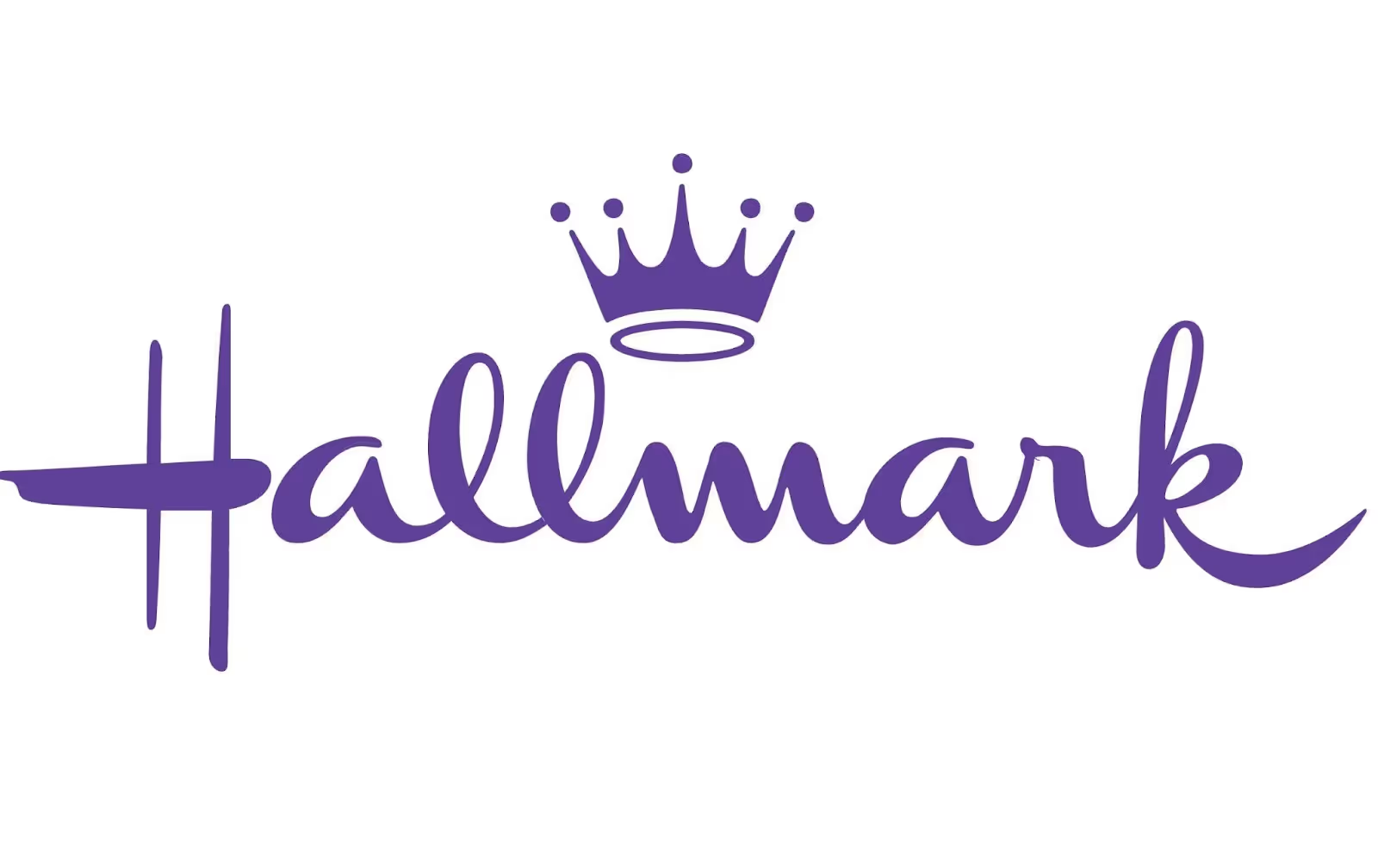
This matters because when your brand looks and sounds consistent, it builds trust. That familiarity builds customer loyalty.
Step 5: Choose Your Card Specifications
Before you think about designs or quotes, lock in the basics like card size as it decides how your design feels.
Picture how you want your cards to look then decide the material, and printing method that will work best.
Card Sizes
- A7 (5" × 7"): The standard size you’ll see in most shops.
- A6 (4.5" × 6.25"): Good option if you’re mailing often.
- Square (5.25" × 5.25"): Works great for minimal designs.
- Mini Cards: Small and simple for gift tags or small gestures.
Card Materials and Finishes
- Matte: Smooth and easy to write on. Works well for simple designs or handwritten notes.
- Glossy: Shiny, colorful, and perfect if you’re using photos or bright illustrations.
- Semi-Gloss/Silk: Has a softer look and isn't too shiny.
Also Read:
Create Your Card Designs
If you are an artist, you can start a card business to earn a passive income stream. If you aren’t creative, you can simply hire someone.
- Design Yourself: Start your design with Canva or Procreate, as they’re easy to learn. Use templates till you get the hang of colors and spacing.
- Hire a Designer: Hop on Fiverr or Upwork. You’ll find plenty of designers who can design greeting cards.
Best Practices
A few design habits can save you from printing headaches later.
- Go for 300 DPI images, as low-res art looks fuzzy once printed.
- Leave breathing room inside for personal notes or signatures.
- Always test your layout at real size before uploading.
- Add bleed and safe zones to avoid cut-off designs.
Step 6: Partner with a Print on Demand Service
With print on demand, you handle the designs and your partner takes care of the rest.
Here are some reasons you should consider POD when you start a card business.
- No upfront inventory costs
- Only pay when you make a sale
- No minimum order quantities
- Automatic fulfillment and shipping
- Test unlimited designs risk-free
- Scale without warehouse space
What to Look for in a POD Partner
Choosing a print-on-demand partner isn’t just about who’s cheapest — it’s about who makes you efficient. Here’s what to check before signing up.
- Print Quality: Order a few samples first. You want clean, bright prints on sturdy cardstock that feels good to hold.
- Fulfillment Speed: Customers expect fast shipping and long delays can tank your reviews.
- Pricing Structure: Look closely at base costs and shipping fees. You should still have room to price your cards fairly and make a profit.
- Platform Integrations: It should plug easily into your shop so orders go through automatically.
- Customer Support: You’ll need a team that actually replies when you reach out.
- Design Tools: A simple mockup or template tool can save hours, especially if you’re still testing your style.
Choose a good POD partner like Podbase to start a card business. Podbase built its name around custom phone cases and laptop skins, but don’t let that limit you.
The platform’s printing quality, product previews, and order handling work just as well for greeting cards. It’s dependable, easy to use, and scales nicely once sales pick up, so get started with Podbase.
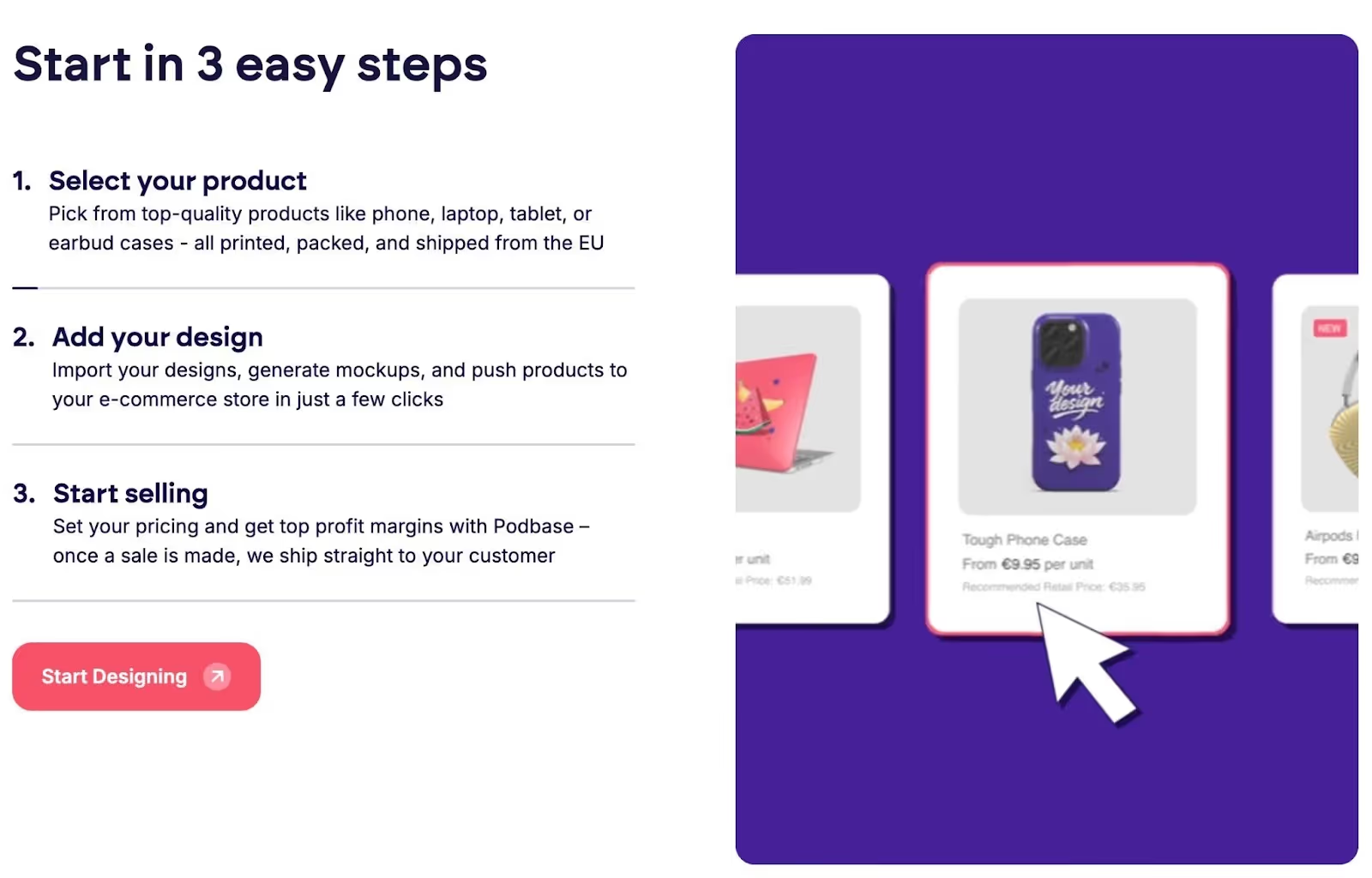
Step 8: Set Up Your Online Store
Once your designs are ready, it’s time to go online. Here’s how the platforms compare:
Create Compelling Product Listings
When you start a print-on-demand business for greeting cards, make sure you create compelling listings. Here’s a checklist of what you should include.
Product Titles
- Add your main keyword, but make it sound natural
- Mention who and what it’s for
Product Descriptions
- Include size, material, and finish
- Note if it’s blank inside or has a message
- Mention envelope details and care instructions
- Highlight special features or audience fit
Product Visuals
- Use clear, high-quality mockups
- Show the front, inside, and envelope
- Add a size reference (hand or ruler)
- Include lifestyle photos in real settings
Example:

Pricing Strategy
- Account for production, fees, and margins
- Check what others in your niche charge
- Match pricing to your brand’s feel
- Test small price changes
Step 9: Market Your Greeting Card Business
Once you start a card business, don’t forget to market it. Use a mix of organic and paid strategies to get the word out about your new card business.
Leverage social media marketing, email marketing, offline marketing opportunities or paid marketing to showcase your card designs and SEO to get traffic to your website.
Also Read:
Conclusion
You just need some good designs and hustle to start a card business.
Test a few ideas online, gather feedback, and keep iterating until something clicks. Niche work and personal storytelling often beat broad, generic offerings for repeat sales.
Choose a POD partner that delivers consistent prints and quick fulfillment every time.
Podbase makes printing, mockups, and order handling easy for small creators. Try Podbase and publish your first card collection today.






